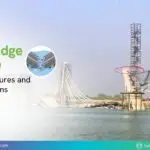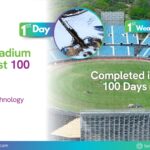Asset Management in Public Infrastructure in USA Can BIM lead the way
June 24, 2022

The $20 trillion US economy heavily relies on a vast network of public infrastructure from public transport to bridges to electrical grids, water carriage systems, and more. The country saw a historic movement in November 2021 when the government announced a commitment of hundreds of billions of dollars toward building new infrastructure. However, the existing infrastructure is rather overstretched and needs maintenance to be able to support ongoing needs.
The report Well Maintained: Economic Benefits from more Reliable and Resilient Infrastructure published by The World Bank in May 2021 effectively documents how good and timely infrastructure maintenance boosts prosperity, enabling growth and well-being of people, firms, and economic systems. Estimating (just) the direct costs imposed on firms in low- and middle-income countries, sales losses due to power outages amount to $82 billion a year; disruptions to the water supply infrastructure cost $6 billion annually, and reduced utilization rates of transportation due to disrupted infrastructure cause a loss of $107 billion a year. These estimates exclude indirect copying costs, loss of competitiveness, and capacity to attract investments.
Maintaining existing infrastructure is therefore as critical as investing in the upgrades. Asset maintenance and management of existing assets are not free from its challenges – complying with complex standards set by the civil authorities as well as internal quality norms, data validation, and integration workflows, asset handover and data sharing between various teams, combining disparate sources of data from various teams to create a unified view, and automating infrastructure asset management to save time and money, are a few of the key challenges by infrastructure owners.
Here's where BIM can play a significant role. Let us look at an example from a project-based in Columbia, USA.
A water and sewerage authority in USA which offers a range of water services, needed a provider of BIM services and ongoing technical support for a pilot study to implement a software solution capable of integrating BIM models and asset data for their Water Pumping Station. A twin asset via a BIM model that includes complete asset history, and accurate real-time information across asset portfolios and locations reliably support better planning of maintenance, repair, and replacement and lesser time spent for asset maintenance. The downtime needed for maintenance can be reduced as the BIM models help us plan for various ‘what if’ scenarios.
The owner of this project had scanned certain facilities and built as-built 3D BIM models. The asset data that was to be linked to the assets in the model was available at various scattered physical locations and was dependent on people accessing them. Since the water supply network is spread over multiple locations, it was necessary to have an integrated picture of the assets in one place. This was the biggest challenge that needed to be addressed.
The general requirements of this project included – key user capabilities, IT security, standards, and miscellaneous. The pilot execution stages included – project kick-off workshops, demonstration and training, end-user testing and feedback workshops, system updates, and implementation of solutions. Their Request for Proposal also stated that in addition to the services and ongoing technical support provided for the pilot study solution, the vendor shall provide details of what is needed to scale up the solution for system-wide implementation.
For linear assets, the organization uses ArcGIS as a solution that provides a visual interactive interface for managing water and sewer pipes, valves, manholes, hydrants, and other assets within the transmission, distribution, and collection networks. Another software provides connectivity between ArcGIS and asset information through a visual interface. Integration with analytical software supports criticality analyses, which are performed to determine linear assets at the highest risk of failure for inclusion in capital replacement and maintenance projects.
In comparison, facility asset information (pumping stations, storage facilities, non-process facilities) is not accessed via a centralized visual interface. Information for facility assets is available in the form of record drawings, SOPs, O&M manuals, service manuals, operating information, and maintenance records. This information is stored in multiple systems such as Enterprise Resource Planning, network drives, Maximo, Wonderware (SCADA), SharePoint, and printed copies. Observing the many advances in technology around facility management, the Department of Pumping and Sewer Operations is evaluating the possibility of incorporating BIM into the existing asset management process. The desired end goal is to centralize access to existing information using an interface that is simple and intuitive.
As a first step, a pilot study is being planned for one of its pumping stations to assess the current technology and associated costs and benefits for the systemwide deployment of a visually interactive information interface for vertical asset management.
For any asset management project in general, a digital twin (aka a BIM model) would be immensely helpful as it can be a storehouse of data that includes asset history,
its operation, its size, dependencies, and disaster recovery. This easily accessible asset data supports better planning of maintenance, repair, and replacement and reduced time in asset maintenance.














